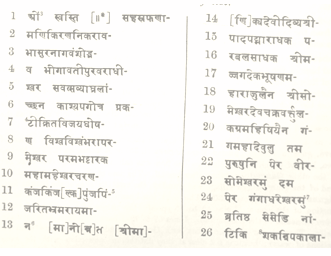|
The Indian Analyst
|
North Indian Inscriptions |
NAGPUR MUSEUM INSCRIPTION OF SOMESVARA. He claims to be a descendant of the race of the Nâga with thousand hoods, i.e. of the serpent Śêsha, to be the lord of the city of Bhôgâvatî, to have for his crest a tiger with a calf, to belong to the Kâśyapa gôtra, and to be a worshipper of the god Mahêśvara and of the goddess Mâṇikyadêvî. In his Dynasties of the Kanarese Districts (p. 95 ff.) and in this Journal (p. 230 ff.), Dr. Fleet has given details of two branches of the Sinda family, which were established at Bâgaḍage and at Erambarage, and which were tributary to the Western Châlukya and Kalachuri dynasties.1In the Bhairanmaṭṭi inscription (No. 33 above), the members of the Bâgaḍage branch od the Sinda family are stated to be descendants of6 the race of serpents (Nâgavaṁśa), to use the crest of a tiger, and to be the lords of the city of Bhôgâvatî. As three similar birudas are applied to Sômêśvara, during whose reign the subjoined inscription is dated, it is clear that he must have been connected with the Sinda family. But as the inscription does not mention any of his ancestors, it is vain to conjecture whether he was a direct descendant of the Bâgaḍage branch, or of Vikrama, the last representative of the Erambarage branch who is noticed by Dr. Fleet, and whose latest inscription is dated I the Śaka-year 1102, twenty-eight years before the subjoined inscription.
TEXT.2 B.â Back of Slab.
......1 Compare also the Tiḍgundi plates, published by Professor Kielhorn, above, p. 306 ff.
| ||||||||||||||||||||||||||||||||||||||||||||||||||||||||||||||||||||||||||||
| > |
|
>
|










